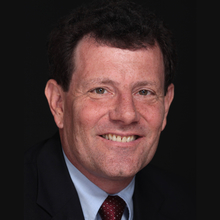Nicholas D. Kristof is a columnist for The New York Times, a two-time Pulitzer Prize winner, and former Beijing correspondent for the paper.
This reporter saw troops fire on and kill people on the Avenue of Eternal Peace on the northern part of the square as well as some who were on a segment of the square just north of the avenue, near the Tiananmen Gate. But there is no firm indication that troops fired on the students occupying the monument in the middle of the square. On the Museum's Roof
There is also no evidence of machine-gun emplacements on the roof of the history museum that were reported in the Wen Wei Po article. This reporter was directly north of the museum and saw no machine guns there. Other reporters and witnesses in the vicinity also failed to see them.
The information in the Wen Wei Po article about students having 23 assault rifles and trying to return them to the army does correspond to a rumor that may have been correct. The rumor also reported, as does the article, that the army refused to take them back so that it could accuse the students of staging an armed rebellion.
But the article reports that the weapons were destroyed on the steps of the monument and this would have been difficult to do covertly. This reporter and many others were wandering about that day and some were constantly stationed on the monument. None of the correspondents there are known to have reported seeing any weapons destroyed.
The article reports that the lights on the square were extinguished at 4 A.M., and this is confirmed by three people who were on the square all night, two Chinese students and one French correspondent.
The central theme of the Wen Wei Po article was that troops subsequently beat and machine-gunned students in the area around the monument and that a line of armored vehicles cut off their retreat. But the witnesses say that armored vehicles did not surround the monument - they stayed at the north end of the square - and that troops did not attack students clustered around the monument. Several other foreign journalists were near the monument that night as well and none are known to have reported that students were attacked around the monument.
The witnesses give the same account. While troops were shooting in all areas around the square, they did not attack the students clustered around the monument. Instead, the students and a pop singer, Hou Dejian, were negotiating with the troops and decided to leave at dawn, between 5 A.M. and 6 A.M. The students all filed out together. Chinese television has shown scenes of the students leaving and of the apparently empty square as troops moved in as the students left. Few Could Have Remained
The witnesses do not definitely assert that nobody was killed in the center of the square. Some workers and students may have remained behind, but they would have numbered not more than in the dozens. Some protesters may also have been in the tents and been crushed by tanks, but they too would have been a relatively small number. The great majority left unhurt and were not shot at, the witnesses say.
The Wen Wei Po article also reported that the author had returned to the square in the early morning. But other witnesses say that the area was blocked off by thousands of soldiers and that there was still shooting going on in the area, so that it would have been difficult to go back.
The Wen Wei Po article catches the atmosphere and the terror but it has the clashes unfolding in the wrong place. On the Avenue of Eternal Peace, on the northern edge of the square, protesters were being killed by machine-gun fire, but not at the monument.
Continue reading the main story





